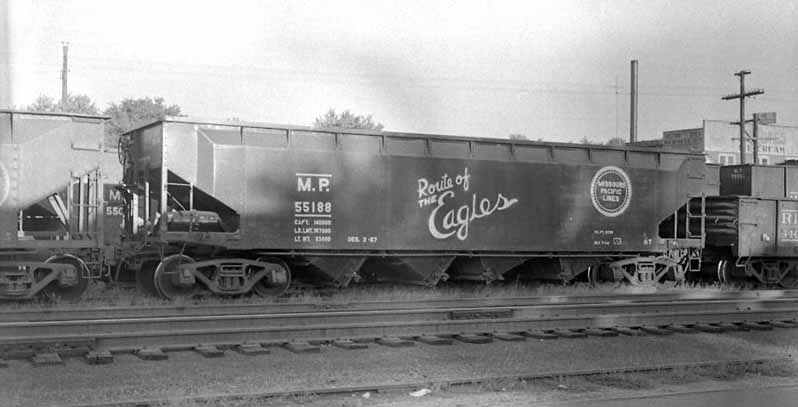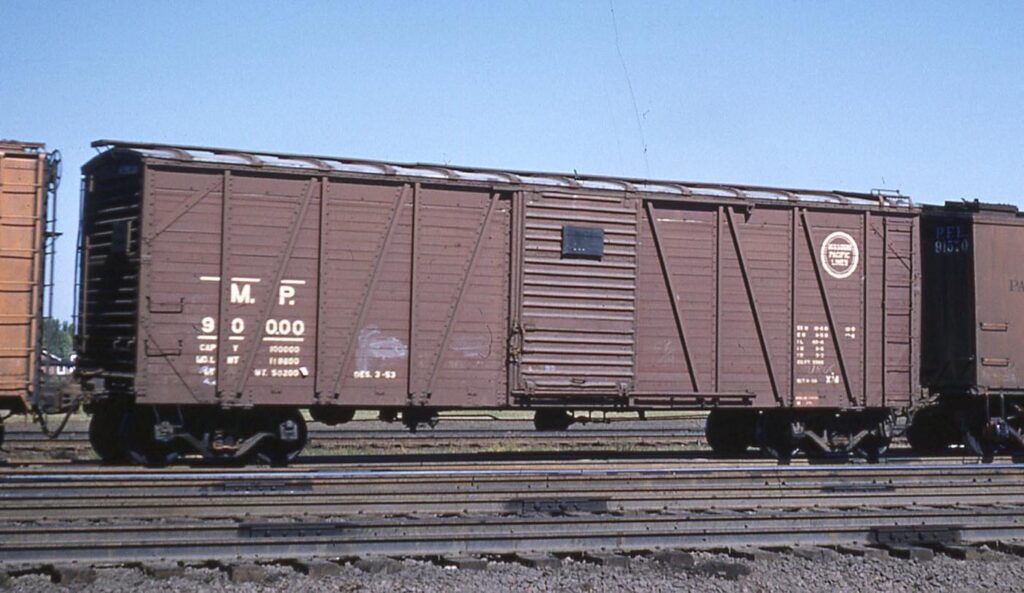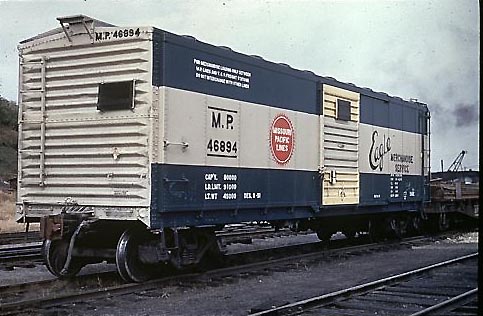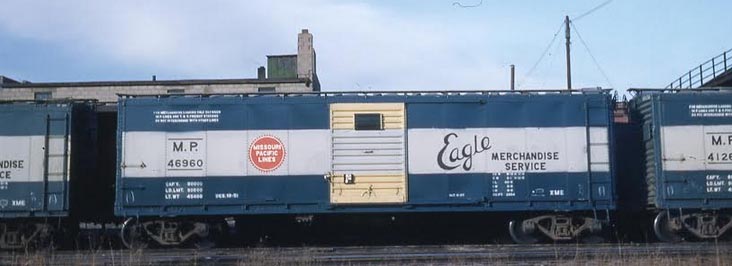Results for {phrase} ({results_count} of {results_count_total})
Displaying {results_count} results of {results_count_total}
Menu
Freight Car Painting Notes from Ed Hawkins
MoPac’s earliest open hopper cars that were built in 1925 and all subsequent open-type cars were painted black with white stencils until 1961. During this time black paint was used on twin, triple, and quad hoppers, ballast cars, flat cars, pulpwood cars, gondola cars, and even some “roofed” hopper cars. The last MoPac freight cars painted black that I know of were gondola cars with coil covers built in June 1960.
I don’t have an exact date, but with the new management in place (Mr. Jenks and Mr. John German as Chief of the Mechanical Department), starting around mid-1961 all freight car types previously painted black were to receive freight car red paint. At roughly the same time MoPac ceased applying “Route of the Eagles” stencils on freight cars (a check of two MP stenciling drawings for a gondola and 50 ton boxcar both show ‘Route of the Eagle removed on 3-16-61 CAD). This change closely coincides when MoPac locomotives and passenger cars previously painted in Eagle colors or switchers painted black began to receive all-blue paint. Effective dates of M.P. locomotive painting & lettering drawings were in May and June 1961.
There are photos of MoPac quad hoppers in Railway Prototype Cyclopedia Volume 5 (out of print) and one additional MoPac photo published as part of an addendum in RP CYC Volume 14. However, when those articles were published I did not have any of the quad hoppers with the Route of the Eagles slogan.
Thank you, Nate, for posting the MP 56188 photo as it’s the only quad hopper photo I’ve seen with the Eagles slogan.

The upcoming BLI quad hopper cars, as well as Athearn model that has been available for decades, is based on a B&O prototype having an inside length of 41′-3″. There are a number of differences between B&O’s and MoPac’s quad hopper cars. MoPac’s cars were 8″ shorter with a 40′-5″ inside length, a slightly different side design as well as differences in the side ladders. But the BLI and Athearn models are likely to be the closest HO-scale models to be found.
Stock car painting
For any cars MoPac box or stock cars built by ACF during the 1940s, the bills of materials are usually silent on the painting of running boards. However, in the case of the stock cars built in 1940 they were specifically called out to be unpainted, which the two builder’s photos also show.
Stock cars I-GN 54000-54099 (lot 2073) and NOT&M 54100-54199 (lot 2072) built in 1940 used “Pittsburgh Carhide Red” on the inside and outside of the the sides and on the ends, roof, and floor. Black underframe, trucks, and bottom of floor. ACF paint samples for lots 2072/2073 (as they would have appeared in 1940) closely matched Scalecoat #13 Box Car Red or Tru-Color ATSF Mineral Brown #19, either one straight from the bottle. The paint sample is a relatively dark shade of brown. If using the ATSF Mineral Brown #19, I suggest lightening a bit with light gray otherwise I think it will look too dark on the model.
Repainted box and stock cars of the 1950s would have more red, like Tru-Color #188, which I believe is the best color for MP “box car red” freight cars as they appeared in the 1950s. This color closely matches the Branchline cars done for the MPHS.
An overhead photo taken at DeSoto of I-GN stock car 53936, new 9-44, appears to have freight car brown on the roof and running board. This photo was published in The Eagle in the special article about livestock and MoPac’s stock cars that we worked on jointly. This car had a steel roof whereas the 1940 ACF stock cars had wood roofs.
New DeSoto-built box cars during the early 1950s had black roofs (to the extent that can be determined in photos). The portion of the running boards visible in photos typically show they were a dark color. For these cars I use black for the running boards, but it’s doubtful that the painters were careful to ensure the running boards were entirely covered.

MP 90000 taken by Lou Schmitz in 1954 Council Bluffs. Note the unpainted galvanized steel with the exception of having their seam caps coated. MPHS Collection

Eagle Merchandise Service 40′ boxcar painted in Mopac’s passenger colors of Eagle Blue, Eagle gray with yellow doors painted on the upper and lower thirds. Roof was unpainted galvanized steel with the exception of having their seam caps coated and painted in Eagle Gray. Underframe and trucks were black.

Another Lou Schmitz photo from the MPHS collection of a 40’Eagle Merchandise car taken in Omaha, Nebraska. Comparing the two color photos you’ll notice the Mopac changed the ends of the cars from Eagle gray to Eagle Blue at some point in the mid-1950’s.
Mopac Rebuilt Boxcars in the 1950’s – Roof colors
I covered this to the extent of my limited knowledge in RP CYC Vol. 14. Other than the XME cars in which the painting diagram exists, everything else is based on photos. From what I see in the photos, MP either left them unpainted (but sometimes coating just the seam caps to help avoid leaks) or coated the entire roof with black car cement. Variations appear to depend on when the cars were built and possibly the car shop.
At least some were left unpainted galvanized steel with the exception of having their seam caps coated. See p. 19 for StLB&M 3306 that shows a good view of the roof of a rebuilt car after a relatively short time in service. That may have been how Kingsville did it. Also, from what I can determine from the photo of MP 42005 (p. 15), this car had an unpainted galvanized steel roof. This car had seen very little service after being rebuilt 11-51.
On the other hand, the side views of MP 41568 (p. 27) and I-GN 16074 (p. 31) show black car cement on the roofs. These cars were rebuilt in the 1953-1954 time period, so it’s possible that MP decided to change their painting specs in 1952-1953. By the way, this time period coincides with new steel box cars like the Branchline models we did for the MPHS, photos of which show black roofs when built.
It’s a shame that the DeSoto box car paint specs apparently weren’t kept, as they would answer a lot of questions.
Ed Hawkins
Originally posted by Charlie Duckworth, 8 June, 2014
All Content Copyright © Missouri Pacific Historical Society, 2024, unless otherwise indicated. By using this site, you agree to our Terms of Use and Privacy Policy.
Your membership supports production of our quarterly magazine, The Eagle, our annual calendar, and our continuing efforts to digitize and present our archives.
Regular Members receive 4 issues of the Eagle, MPHS Calendar, member discounts at the Company Store, full access to the MPHS Archives, and access to participate on the MPHS Forums.
Based on 12-month period beginning with receipt of dues
Includes a subscription to our quarterly magazine, The Eagle
New members will receive the current issue of The Eagle upon receipt of dues
Includes a full-color calendar for the following year (issued with 3rd quarter The Eagle)
Includes a 5% discount on many items in the company store
Access to the online MPHS Forums
Available anywhere in the world
Sustaining Members receive all the benefits of Regular Members, plus donate $25 toward MPHS Operating Expenses.
Recognition in The Eagle.
Based on 12-month period beginning with receipt of dues
Includes a subscription to our quarterly magazine, The Eagle
New members will receive the current issue of The Eagle upon receipt of dues
Includes a full-color calendar for the following year (issued with 3rd quarter The Eagle)
Includes a 7.5% discount on many items in the company store
Access to the online MPHS Forums
Available anywhere in the world
Your name listed in The Eagle
$25 of your dues are tax deductible
Eagle Members receive all the benefits of Regular and Sustaining Members, plus donate $50 toward MPHS Operating Expenses.
Recognition in The Eagle.
Based on 12-month period beginning with receipt of dues
Includes a subscription to our quarterly magazine, The Eagle
New members will receive the current issue of The Eagle upon receipt of dues
Includes a full-color calendar for the following year (issued with 3rd quarter The Eagle)
Includes a 10% discount on many items in the company store
Access to the online MPHS Forums
Available anywhere in the world
John Bromley print (new members, not renewals)
Your name listed in The Eagle
$50 of your dues are tax deductible